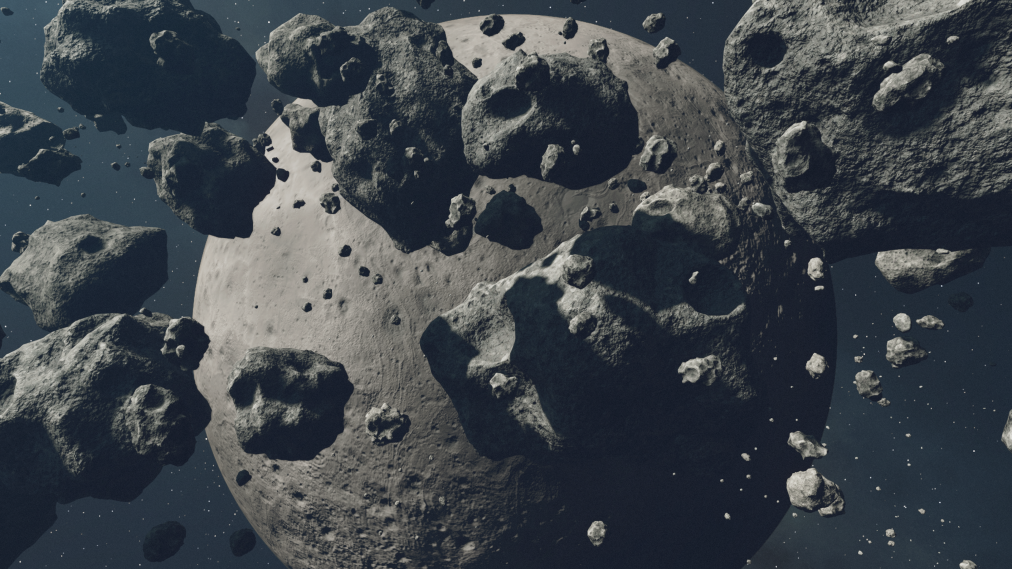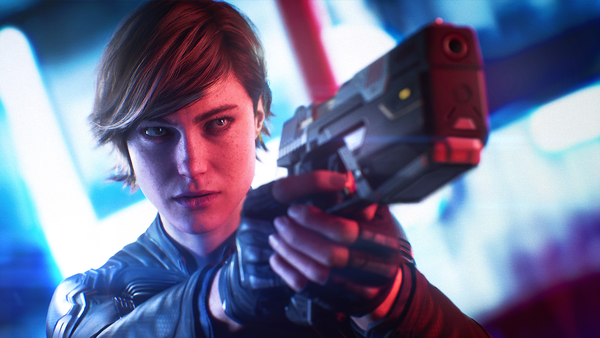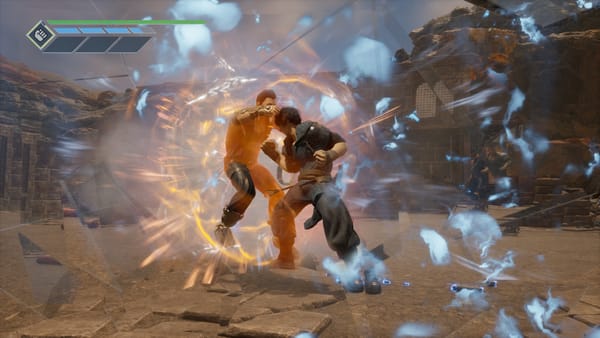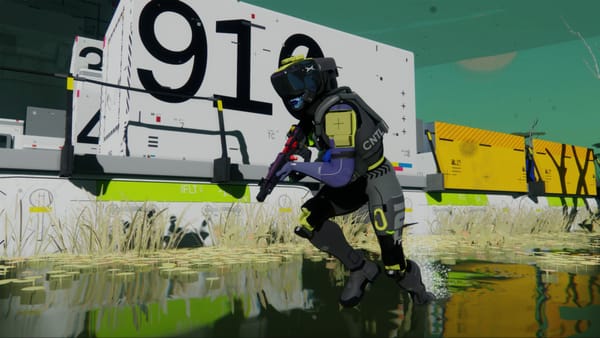#222: My god, it's full of seams
Hit Points [loading...] is very much enjoying [loading...] Starfield, the oldest game of the year.

Hello! Welcome back, free readers, to Hit Points, which is now five days back from holiday (and yes, it already feels like a lifetime ago). Earlier this week, the paid crew got their weekly exclusive on what we’re temporarily calling Premium Early Access — the ‘pay more, play early’ model that’s been bubbling away for a while now, and finally came to the boil with Starfield’s arrival last week.
As a reminder, a subscription to Hit Points costs just £4 a month, auto-converted by Substack to your local currency equivalent. It gets you access to the full archive and an extra edition each week, and helps support my ad-free, SEO-ignorant, fully independent work, which unlike the rest of today’s media definitely isn’t under any sort of threat from the rise of the machines. They call it ‘artificial intelligence’ but can ChatGPT come up with a good joke about John Riccitiello’s outfit? I’ve tried and, no, it cannot. Anyway, on with the show.
Before we go any further, I would like to make it clear that I am absolutely loving Starfield. Since paying like a sucker for Premium Early Access last Friday — in my defence it was the last weekend of my holiday and I figured I’d have less time to play it once I was back at my desk, yes I realise I’m part of the problem, leave me alone — I have played the game for more than 25 hours. These days I only rack up those sorts of numbers if I’m being paid for it. It has got its hooks in for sure: to be quite honest, I would much rather be playing it right now than writing this. Is there a word for this feeling, when a game takes such a hold of you that you resent doing other things? Perhaps in German? One of the Scandinavian languages, perhaps, they have some great ones.
Despite the hype campaign, its status as the first true Series X/S system seller, and the breathless tone of some of the coverage around it, I am struck by just how old Bethesda’s new game feels. I am not saying that is a bad thing: in fact, I think that is what I most like about it. As I pointed out to paid subs earlier in the week, Premium Early Access is Starfield’s sole monetisation strategy beyond the cost of buying the game: there is DLC coming in the future, but at launch it has no battle pass or cosmetic store, no loot boxes or any of the other dark-arts bullshit that so plagues today’s triple-A landscape. It’s quite refreshing, albeit old-fashioned, for a developer to just take my money, give me a big game and set me loose in it.
It is a game with an old heart, is our Starfield, and whether you see this as a blessing or a curse is largely a matter of perspective, and of context. It really does feel to me like Skyrim in space, rekindling fond memories of the hinterland between Christmas and New Year in 2011, when it was brutally cold outside and my wife and I spent several days hunkered down, in pyjamas in front of the fire, adventuring our way across Tamriel. (This was, needless to say, in the time before children. We’d never get away with doing that today; if we kept the boys indoors like that one of them would have put the other in hospital by lunch on the first day.) The setting might have changed completely, but the rhythm and the flow — the soul, I suppose — of the two games is much the same, and it turns out I like it as much today as I did in 2011. Lovely stuff.
Elsewhere, however, are near-constant reminders of how far we have come, and just why we have left behind the things we have. I could write an entire edition on the writing, but let me just say that I am not sure that everyone in this universe of ne’er-do-wells, from space pirates to avaricious corpos, drug pushers to smugglers and activist hackers and everyone in between, should be so thoroughly nice, nor have all their lines read like they were written by the same person. There is an awful lot of writing in Starfield, but I’m not sure I could really tell you about any of it, much less enthuse about it.
And then there are the load screens, which are everywhere, and make it impossible to get into a proper flow with the thing. It’s like the way tabloid newspapers start a new paragraph for every sentence.
Can you imagine if Hit Points did that?
It would be terrible.
Starfield, for all the sprawl of its universe, is a miserably fragmented experience. While I accept that the sheer size of the game’s starmap means that space travel was probably never going to be fully seamless, I am nonetheless disappointed by how… seamy, for want of a better word, it really feels. While neither No Man’s Sky nor Elite Dangerous have ever clicked with me as readily as Starfield has over the past week, they at least understood that, for a spacebound world of this size to feel meaningful, it has to be open. At its worst Starfield feels like I am simply picking levels off Super Mario World’s map — as if a Goomba in Forest Of Illusion 1 has asked me to deliver a letter to a Koopa in Cheese Bridge Area, and I’ve got distracted by a Ghost House along the way.
If anything, I find the sense of disconnection on the ground even more maddening, the loading screens when transitioning between areas, and even from bustling city to single-room bar, killing any prospect of immersion stone dead. The Witcher III managed seamless interiors and exteriors a decade ago, and that ran on Xbox One, a console made of actual potatoes. It runs on a Switch, which I think these days is about as powerful as my fridge. You could get away with this in the 360 era, sure. But today, any loading screen longer than a half-second is an invitation for me to pick up my phone and get distracted, and I’ve already done that in Starfield more times than I can count.
I suppose we will never know, pending a Bloomberg exposé that I imagine is in the works, whether these problems are limitations of ambition, execution or technology. I expect there are elements of all three — and I can certainly imagine there being a prevailing attitude of ‘this is how we’ve always done it’ in a studio of such longevity and success — but we can probably pin the bulk of it on the tech. Starfield is, after all, still built on Bethesda’s Creation Engine, which it has been using since Skyrim; it is based on Gamebryo, which dates back to the late 1990s and was first used by Bethesda in Oblivion. In the making of Fallout 3, the only way the studio could add a working train was by giving an NPC a locomotive for an arm, then having said character run along underground when the player started the engine. That was a Gamebryo game rather than a Creation one, sure. And Bethesda says it has updated its long-serving technology specifically for Starfield. But I’m not convinced the results here reflect a set of tools that are fit for modern purpose, or ever really have been.
Look, all of this is fine. If we are to be quite honest with ourselves, none of us really expected Starfield to push any technical boundaries. And, as I say, I am thoroughly enjoying my time with the game. But my personal expectations were certainly raised by Microsoft’s involvement, and by Bethesda’s newly fashioned status as the jewel in Xbox’s crown. I am reminded (once again) of a story told to me by Allen Murray, the debut subject of Hit Points’ occasional interview series Max HP, about a visit Phil Spencer, then merely a senior member of the Xbox team, made to Bungie after the studio had shipped Halo 3. “We were so high on our own supply,” Allen told me. “We were so fucking cool, nobody could tell us what to do. There was a lot of attitude and hubris going round. Phil came in and basically said, ‘You’ve made another Halo. That’s great. But that’s what everybody expects you to do. We know you can do that.’” Lots of Bungie folks were livid, but Allen saw it differently: “What I took from it was, ‘You can do better. You can do more. You can do something amazing.’”
Now, Starfield was already in development by the time Microsoft completed its $7.5bn acquisition of Bethesda’s former parent company Zenimax Media; it was likely too late to make any substantive changes, particularly to the technology the game was being made with. But I am struggling to see much evidence of Microsoft’s hand elsewhere in the game. As one wag put it on a forum earlier this week, $7.5bn later, NPCs are still ghosting through doors.
A number of the reviews I’ve read pay tribute to how bug-free the game is at launch for a Bethesda title, and I am sure Microsoft’s QA function has worked tirelessly to knock the game into more stable shape than, say, Skyrim was at launch. But, firstly, that is not the highest bar to clear, is it? And in any case this is still a very buggy game. I think my favourite so far came after I got spotted in a stealth section and simply sprinted through the facility, and when I triggered the conversation at the end my companion joined in. Unfortunately she hadn’t been able to match me for pace, and was still in a firefight two rooms away. She got halfway through her line and keeled over in a hail of bullets. The conversation restarted, and when she next spoke she was on all fours, one hand trying to hold her stomach in, coughing up blood while gunfire spattered the ground around her. Excellent stuff, honestly. No notes.
I suppose no Bethesda game was ever going to carry the hopes and dreams of an entire console fanbase, but I also think it’s fair to say many of us expected them to be able to bear a little more of the weight than Starfield actually does. I feel gently ludicrous saying all this given how much I’m enjoying the game, and am already terrified of the mental gymnastics I’m going to have to perform to justify including this in the Hit Points Awards when there is so much obviously flawed about it in a year so stacked with bangers. But as much fun as I’ve been having, throughout it all I’ve had a constant sense of what could have been — and what ought to happen next. Phil, old stick, if you’re reading, I think it’s time you made another speech.
MORE!
- The Switch successor was shown to developers behind closed doors at Gamescom last month, according to both Eurogamer and VGC. In heartening news for those of us hoping Nintendo’s next console will be a little more attractive on a 4K display, the Unreal Engine 5 showcase The Matrix Awakens was shown running on the system, as was a souped-up, ray-traced version of Breath Of The Wild. Apparently the latter was just a tech demo, but if you really believe Nintendo doesn’t intend to sell us BOTW all over again you’re a mug. I will buy it, obviously, and so will you.
- E3 organiser the Entertainment Software Association has confirmed that there will be no physical event at the Los Angeles Convention Centre in 2024. This careful wording does theoretically mean it’s still possible for there to be an E3 somewhere, but it doesn’t look great. GI.biz reckons the ESA is targeting “a complete reinvention” of the show in 2025 instead. The ESA has also parted ways with ReedPop, whose planned reimagining of E3 this summer hit the skids amid a lack of exhibitor interest.
- Google has begun testing Playables, a suite of instantly, erm, playable games on YouTube born from the ashes of Stadia. The company says “a limited number of users” have been selected; if you’re one of the lucky ones you’ll find a ‘Playables’ section in your YouTube sidebar.
- Here, this is quite sweet: Atari is acquiring AtariAge, a long-running community site that blends a bustling forum with a detailed archive. As part of the deal, AtariAge founder Albert Yarusso has been appointed Atari’s internal historian. Cool!
- Senior executives at blockchain ‘games’ studio Gala Games are suing each other over allegations of corporate waste and general bellendry. The CEO is accusing a director of stealing $130m worth of the company’s GALA token, and wants it back, plus damages; the director says the CEO went rogue and misused $600m of company funds, and wants $750m in return. Obviously this is all very serious stuff, but you have Hit Points’ permission to laugh if you like.
- Skull & Bones, the long-troubled Ubisoft pirate game whose title is now presumably a reference to the physical state of its original development team, has lost a third creative director. To top it all, Ubisoft Singapore must now reckon with the dev team’s bid to unionise. Still, the publisher is putting a positive spin on it all, insisting a recent closed beta went down a storm. We’ll get to find out for ourselves when Skull & Bones launches in 2052.
Right, that’ll do! It’s lovely to be back at my desk, and I appreciate your patience while I shake off the ol’ rust. Have a grand weekend; if you’re at a loss for what to do I will call back to the intro and leave you with the Finnish word ‘Kalsarikannit’, which means ‘drinking alone in your underwear’. Cheerio!





